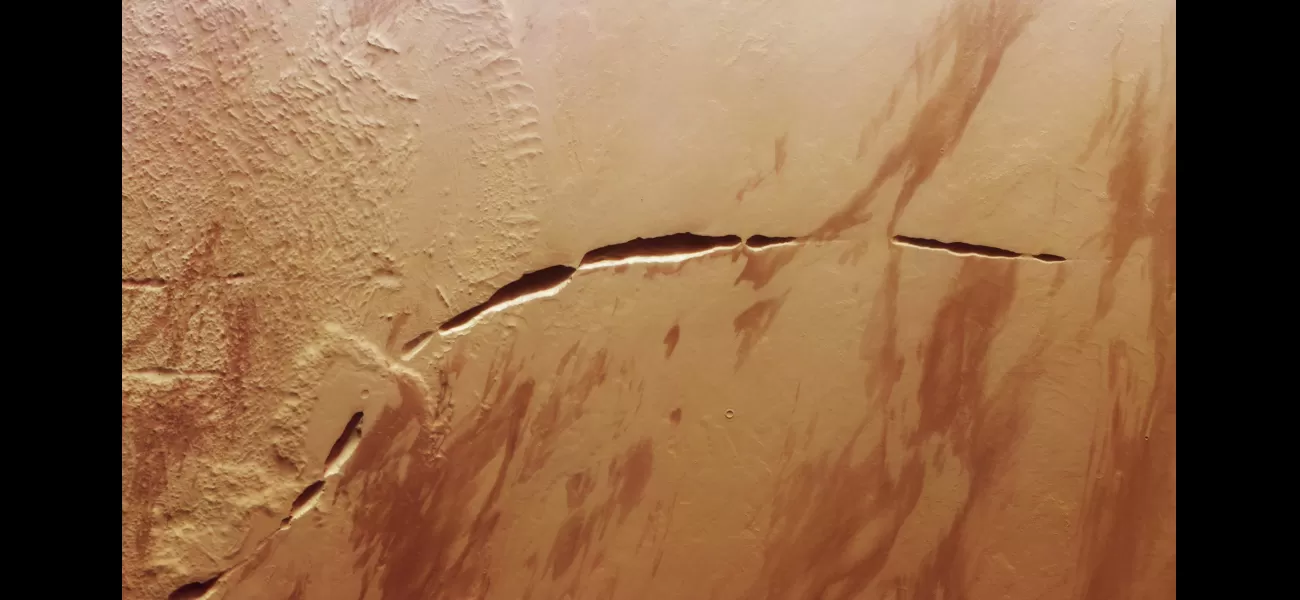Something cut into Mars, creating a mark, and we have no explanation.
New puzzling discovery on Mars.
July 8th 2024.

After years of curiosity and speculation, scientists have finally been able to get a closer look at a mysterious scar on Mars, known as Aganippe Fossa. This incredible feature, stretching over 370 miles, is longer than the famous Grand Canyon. Thanks to the European Space Agency's orbiter Mars Express, we now have clear images of this enigmatic crevice.
Aganippe Fossa, also referred to as a 'graben', is a deep ditch-like groove with steep walls on either side. It cuts across the lower region of one of the Red Planet's largest volcanoes, Arsia Mons. Interestingly, this ravine was first spotted back in 1930, but it's only now that we have been able to see it up close.
According to the ESA, Aganippe Fossa is "a dark, uneven scar slicing through marbled ground at the foot of a giant volcano" and has "steep walls on either side." The origin of this scar still remains a mystery, but it is believed to have formed as magma rising underneath the colossal mass of the Tharsis volcanoes caused the planet's crust to stretch and crack.
The Tharsis region, where Aganippe Fossa is located, is home to several of Mars's behemoth volcanoes. This includes the famous Olympus Mons, which stands at a staggering 18.6 miles high, making it the tallest volcano in the entire solar system. In comparison, Mount Everest is only about two and a half times shorter. Arsia Mons, on the other hand, measures 270 miles in diameter and rises more than five miles above the surrounding plains.
Since 2003, the Mars Express has been diligently exploring the Red Planet, providing us with valuable insights into its surface, minerals, atmosphere, and more. Last year, the spacecraft captured stunning images of the Noctis Labyrinthus, a vast system of deep valleys stretching over 700 miles on Mars. This is longer than the entire length of Italy. The ESA also released images of what Earth and the Moon look like from the perspective of Mars, thanks to the Mars Express.
It's safe to say that the Mars Express has been a valuable asset in our quest to understand the Red Planet. With its advanced technology and continued exploration, we can expect even more fascinating discoveries in the future. As for the mysterious Aganippe Fossa, we may never know for sure how it came to be, but we can certainly appreciate its beauty and wonder.
Aganippe Fossa, also referred to as a 'graben', is a deep ditch-like groove with steep walls on either side. It cuts across the lower region of one of the Red Planet's largest volcanoes, Arsia Mons. Interestingly, this ravine was first spotted back in 1930, but it's only now that we have been able to see it up close.
According to the ESA, Aganippe Fossa is "a dark, uneven scar slicing through marbled ground at the foot of a giant volcano" and has "steep walls on either side." The origin of this scar still remains a mystery, but it is believed to have formed as magma rising underneath the colossal mass of the Tharsis volcanoes caused the planet's crust to stretch and crack.
The Tharsis region, where Aganippe Fossa is located, is home to several of Mars's behemoth volcanoes. This includes the famous Olympus Mons, which stands at a staggering 18.6 miles high, making it the tallest volcano in the entire solar system. In comparison, Mount Everest is only about two and a half times shorter. Arsia Mons, on the other hand, measures 270 miles in diameter and rises more than five miles above the surrounding plains.
Since 2003, the Mars Express has been diligently exploring the Red Planet, providing us with valuable insights into its surface, minerals, atmosphere, and more. Last year, the spacecraft captured stunning images of the Noctis Labyrinthus, a vast system of deep valleys stretching over 700 miles on Mars. This is longer than the entire length of Italy. The ESA also released images of what Earth and the Moon look like from the perspective of Mars, thanks to the Mars Express.
It's safe to say that the Mars Express has been a valuable asset in our quest to understand the Red Planet. With its advanced technology and continued exploration, we can expect even more fascinating discoveries in the future. As for the mysterious Aganippe Fossa, we may never know for sure how it came to be, but we can certainly appreciate its beauty and wonder.
[This article has been trending online recently and has been generated with AI. Your feed is customized.]
[Generative AI is experimental.]
0
0
Submit Comment





